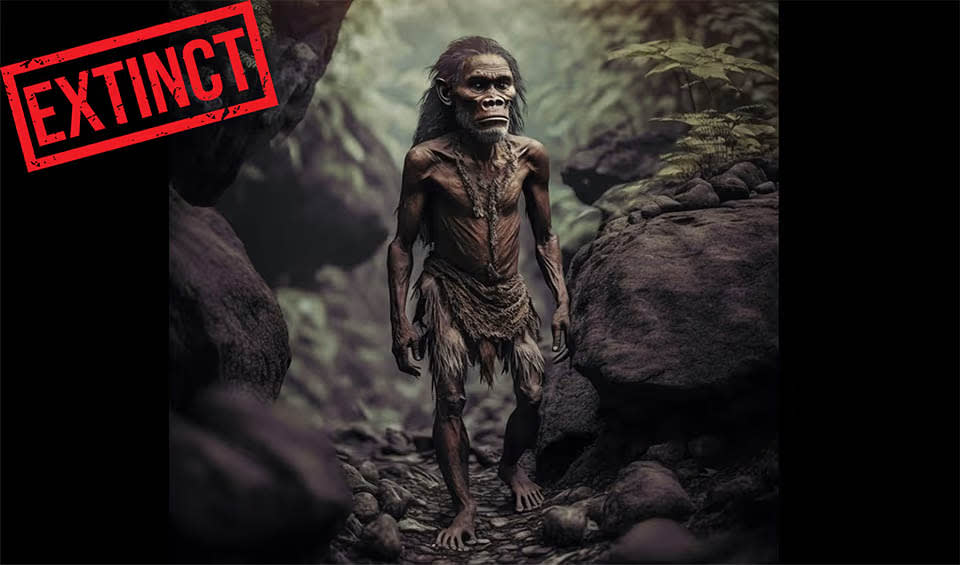The real-life Hobbits of today’s Indonesia were extinct 50,000 years ago with the arrival of us Humans.
Believed to have evolved from a small-bodied population of Homo erectus that became isolated on Flores approximately 1 million years ago, Homo floresiensis is a testament to the incredible adaptability of the human lineage. The phenomenon of island dwarfism—a process where, due to limited resources and the absence of predators on isolated islands, species evolve smaller body sizes—is thought to have played a crucial role in the evolution of Homo floresiensis from their larger-bodied ancestors. This process highlights the profound impact of environmental factors on the course of evolution.
Homo floresiensis stood approximately 1 meter in height and exhibited a unique combination of anatomical features that set them apart from Homo erectus and other human ancestors. Notably, they possessed a small brain size, comparable to that of chimpanzees, and a distinct skull shape. These characteristics have sparked intense debate among scientists about the relationship between brain size and intelligence, as well as the complexity of human evolution. Despite their small brains, evidence suggests that Homo floresiensis were capable of making and using tools, demonstrating that brain size is not the sole determinant of cognitive abilities.
The physical build of Homo floresiensis, characterized by long arms and short legs, indicates a lifestyle that was adept for both climbing and walking. This combination of traits suggests that they were versatile in navigating the rugged and forested terrain of Flores, adeptly exploiting both terrestrial and arboreal niches for survival.
The archaeological record of Homo floresiensis includes stone tools and evidence of fire use, indicating a level of technological and cultural adaptation that challenges the stereotype of smaller-brained hominins as less capable. These findings have led scientists to reconsider the complexity of behaviors and lifestyles that could be supported by smaller brains, suggesting a diverse range of survival strategies among ancient human species.
Distribution
 Asia
Asia Official estimate
Official estimate
Did you know?
- The discovery of Homo floresiensis was initially met with skepticism and controversy. Some researchers suggested that the fossils belonged to a modern human with a medical condition rather than a separate species.
- The small size of Homo floresiensis has led some scientists to suggest that it may have evolved to cope with limited resources on the island of Flores, where it lived. However, others have proposed that its small size may have been due to a genetic condition known as microcephaly.
- The discovery of stone tools associated with Homo floresiensis suggests that they were capable of advanced tool-making and may have hunted small game.
- The closest living relatives of Homo floresiensis are Homo sapiens (modern humans), but they also share some features with Australopithecus and Paranthropus, which lived over 2 million years ago.
- Despite the relatively recent age of Homo floresiensis (around 50,000 to 100,000 years old), its fossils show evidence of dental problems and a shortened life span, suggesting that it faced significant health challenges during its existence.
- Some researchers have suggested that the discovery of Homo floresiensis may indicate that many other unknown hominin species have yet to be discovered.
- The discovery of Homo floresiensis has also raised questions about the definition of a “species” and the boundaries between different types of hominins.
- Also, its discovery challenges our understanding of human evolution, as it suggests that multiple hominin species coexisted at the same time.
Anything we've missed?
Help us improve this page by suggesting edits. Glory never dies!
Suggest an editGet to know me
Terrestrial / Aquatic
Altricial / Precocial
Polygamous / Monogamous
Dimorphic (size) / Monomorphic
Active: Diurnal / Nocturnal
Social behavior: Solitary / Pack / Herd / Group
Diet: Carnivore / Herbivore / Omnivore / Piscivorous / Insectivore
Migratory: Yes / No
Domesticated: Yes / No
Dangerous: Yes / No




